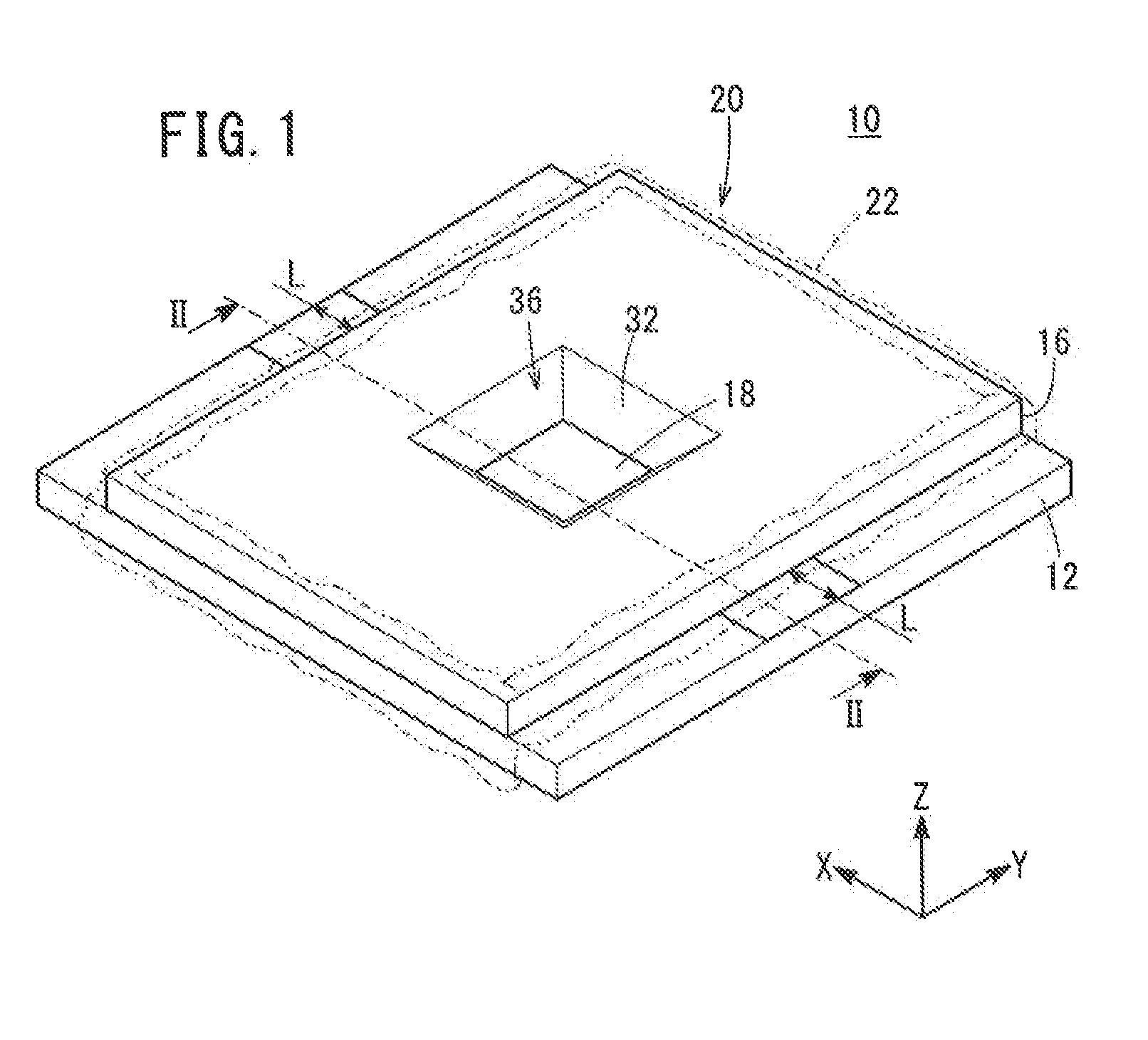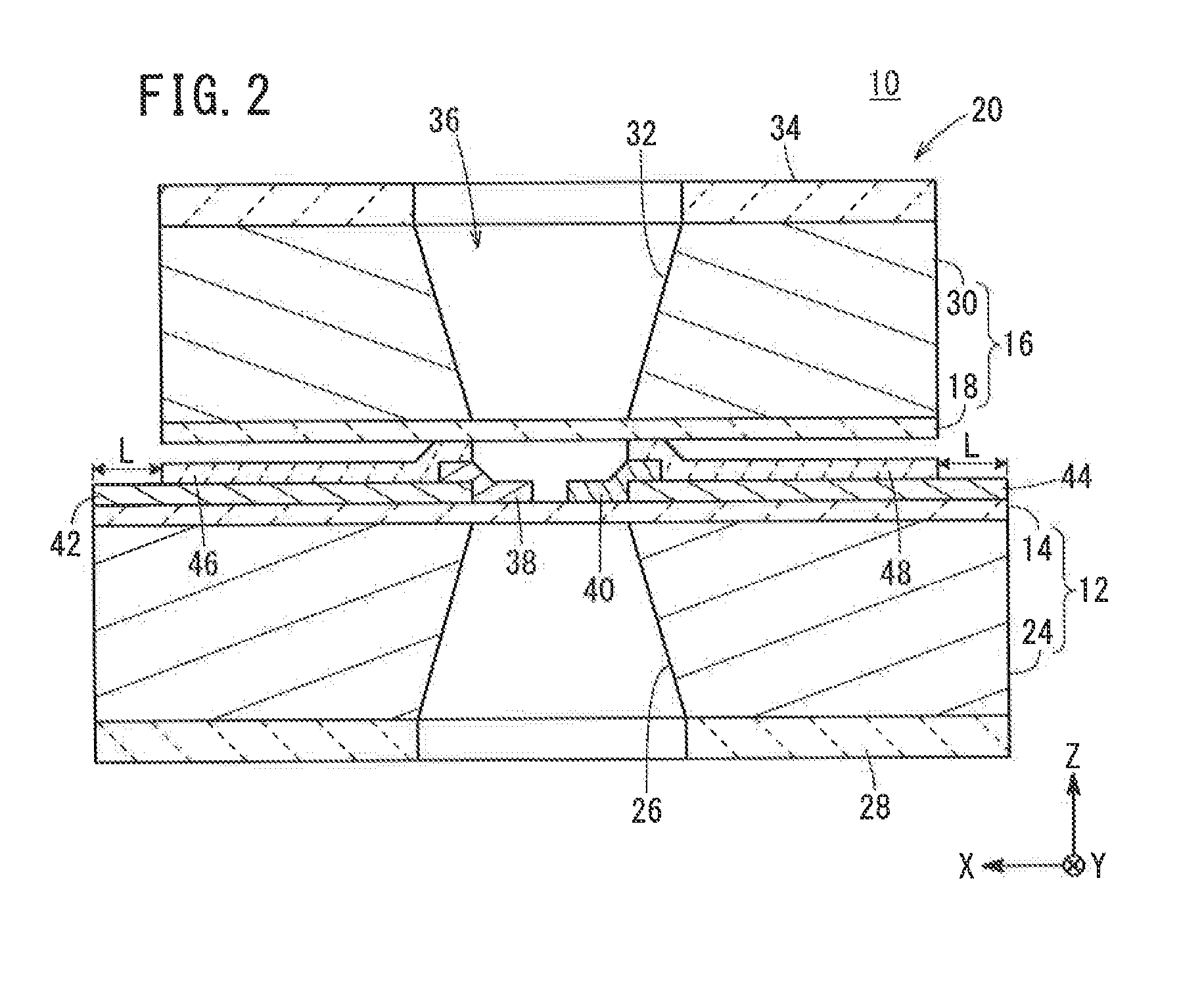Analytical cell
- Summary
- Abstract
- Description
- Claims
- Application Information
AI Technical Summary
Benefits of technology
Problems solved by technology
Method used
Image
Examples
first embodiment
[0066]An analytical cell 10 according to a first embodiment will be described below with reference to FIGS. 1 to 4. FIG. 1 is an overall schematic perspective view of the analytical cell 10. FIG. 2 is a cross-sectional view taken along the line II-II in FIG. 1 in the direction of the arrows. FIG. 3 is a plan view of a transmission membrane (electron beam permeable membrane or electron beam transparent membrane) 14 side of a first holder 12 in the analytical cell 10. FIG. 4 is a plan view of a transmission membrane (electron beam permeable membrane or electron beam transparent membrane) 18 side of a second holder 16 in the analytical cell 10. To facilitate understanding, the X-axis, Y-axis, and Z-axis directions shown in FIGS. 1 to 4 are defined as the width, depth, and height directions respectively in the following description. In addition, in the X-axis, Y-axis, and Z-axis directions, the tip of the arrow is defined as one end, and the base end of the arrow is defined as the other...
second embodiment
[0111]An analytical cell 88 according to a second embodiment will be described below with reference to FIG. 33. FIG. 33 is a cross-sectional view of the analytical cell 88 taken in the same direction as FIG. 2. The components in FIG. 33, equal or similar in functions and effects to those in FIGS. 1 to 32C, are denoted by the same reference numerals, and detailed explanations thereof are omitted.
[0112]The analytical cell 88 contains isolation membranes 90, 92 instead of the isolation membranes 46, 48 in the analytical cell 10. The isolation membranes 90, 92 contain a substance having electrically insulating and electron beam permeable properties. Preferred examples of such substances include silicon nitride.
[0113]The isolation membranes 90, 92 are different from the isolation membranes 46, 48 in that the other end of the isolation membrane 90 and the one end of the isolation membrane 92 reach the inside of the observation window 36. Thus, each of the isolation membranes 90, 92 is int...
third embodiment
[0116]An analytical cell 94 according to a third embodiment will be described below with reference to FIGS. 34 to 37. FIG. 34 is an overall schematic perspective view of the analytical cell 94. FIG. 35 is a cross-sectional view of the analytical cell 94 of FIG. 34 taken along the line XXXV-XXXV in the direction of the arrows. FIG. 36 is a plan view of a transmission membrane 14 side of a first holder 96 in the analytical cell 94. FIG. 37 is a plan view of a transmission membrane 18 side of a second holder 98 in the analytical cell 94. The components in FIGS. 34 to 37, equal or similar in functions and effects to those in FIGS. 1 to 33, are denoted by the same reference numerals, and detailed explanations thereof are omitted.
[0117]The analytical cell 94 contains the first holder 96 and the second holder 98 instead of the first holder 12 and the second holder 16 in the analytical cell 10. The first holder 96 contains a substrate 100 instead of the substrate 24, and the second holder 9...
PUM
 Login to View More
Login to View More Abstract
Description
Claims
Application Information
 Login to View More
Login to View More - R&D
- Intellectual Property
- Life Sciences
- Materials
- Tech Scout
- Unparalleled Data Quality
- Higher Quality Content
- 60% Fewer Hallucinations
Browse by: Latest US Patents, China's latest patents, Technical Efficacy Thesaurus, Application Domain, Technology Topic, Popular Technical Reports.
© 2025 PatSnap. All rights reserved.Legal|Privacy policy|Modern Slavery Act Transparency Statement|Sitemap|About US| Contact US: help@patsnap.com



